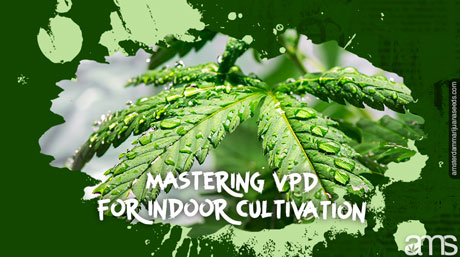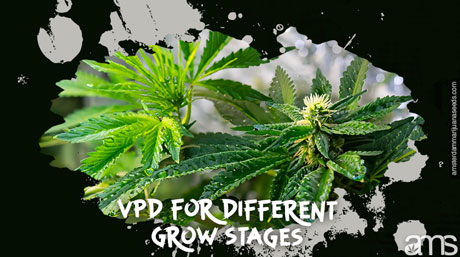As a passionate cultivator of top-tier cannabis, you know that success is sewn in the details. Every choice in your grow room, from light sources to feeding schedules, can profoundly influence the quality of your final product. One of the essential yet often misunderstood aspects of this complex cultivation puzzle is Vapor Pressure Deficit (VPD). Mastering this concept could be your key to unlocking the full potential of your cannabis plants.
To comprehend the role of VPD in cannabis cultivation, we must first break down what it entails. Vapor-Pressure Deficit, or VPD, is the difference between the amount of moisture currently in the air and how much moisture the air can hold when fully saturated. When the air can’t hold any more moisture, it condenses to form clouds, dew, or even a film of water over plant leaves. This last scenario is particularly relevant for indoor growers. Should a film of water form on a cannabis leaf, the plant becomes more susceptible to ailments like rot. Conversely, a high VPD compels the plant to draw more water from its roots, which could potentially lead to the plant drying out and dying.

VPD plays a fundamental role in maintaining the health and productivity of cannabis plants. It impacts transpiration, the process where plants lose water to the air from the surfaces of their leaves. When the VPD is in the appropriate range, cannabis plants can transpire effectively, enhancing nutrient uptake and reducing the risk of diseases and stress.
This balance is crucial because transpiration is not just water loss; it’s part of the plant’s nutrient transportation system. Through this process, nutrients dissolved in water are drawn up from the roots and dispersed throughout the plant. Hence, too high or too low a VPD can inhibit this essential mechanism, affecting plant growth and the ultimate yield. As such, fine-tuning your grow room’s VPD can promote optimal growth rates and significantly influence your plants’ overall health and productivity.
One of the cornerstones of successful cannabis cultivation is recognizing and catering to your plants’ varying needs at different stages of their life cycle. The ideal VPD for your cannabis crop shifts as they transfer, from the vegetative stage to the flowering stage.
During the vegetative stage, the cannabis plant focuses on establishing a robust growth foundation. This phase requires a VPD range of approximately 0.8–1.1 kPa, promoting lush foliage and sturdy plant structures. Striking this balance ensures that the plant is drawing sufficient water from its roots for robust growth.
As your plants enter the flowering stage, their energy redirects towards the creation of dense, resinous buds. Here, the ideal VPD increases to a range of 1.0–1.5 kPa. This shift enhances transpiration, stimulating nutrient uptake to support the buds’ development and growth.
A deeper dive into the science of cannabis cultivation reveals that increased transpiration during the flowering stage can contribute to a more robust terpene profile. Terpenes, the aromatic compounds found in cannabis, are of significant interest to both medicinal users and recreational connoisseurs for their potential therapeutic benefits and influence on flavor and aroma.

Now that we understand what VPD is and its impact on cannabis cultivation let’s explore how to regulate it effectively in your indoor grow room.
VPD is predominantly a function of two factors: temperature and relative humidity. Hence, controlling these two elements in your grow room will allow you to maintain the ideal VPD for your plants. It’s worth investing in a reliable heating and cooling system to regulate temperatures and a dehumidifier or humidifier to adjust humidity levels.
However, regulating VPD isn’t a “set it and forget it” scenario. Regular monitoring is essential to promptly catch any fluctuations that could steer your plants away from their growth sweet spot. Luckily, technology has our backs here, with a range of devices and smartphone apps available to monitor VPD, temperature, and humidity levels.
Mastering VPD is an essential step towards refining your cannabis cultivation process. Still, it’s crucial to remember that it’s just one piece of the puzzle. Balancing VPD with other environmental factors such as lighting, CO2 levels, and nutrition can take your crop from good to great.
In the end, understanding and managing VPD can lead to healthier plants, better yields, and higher quality cannabis. So, put on your gardener’s hat, dive into the delightful complexities of cannabis cultivation, and let VPD guide you, towards a bountiful harvest.
While understanding VPD is a significant stride toward optimizing your cannabis grow, applying it can present some challenges. A common mistake is failing to adjust VPD as your plants transition from the vegetative to the flowering stage. Another frequent error is maintaining a constant temperature and humidity without considering the VPD implications.
Remember, the right VPD varies with plant maturity and changes throughout the day. Overnight, when temperatures drop, relative humidity often rises. If you’re not adjusting your environmental controls to account for these fluctuations, you might wake up to find your VPD out of the optimal range, putting your plants at risk of stress or disease.

Harnessing the power of technology can greatly simplify managing VPD in your grow room. Various tools can help you monitor and maintain ideal conditions. Hygrometers measure relative humidity, thermometers or thermostats control temperature, and combined devices provide real-time monitoring of both. Some of these gadgets can even connect to your smartphone, offering remote monitoring and notifications if conditions drift out of your preset ranges.
For those seeking a more hands-off approach, integrated grow room controllers are available. These systems can regulate temperature, humidity, lighting, and CO2, maintaining the perfect VPD, practically on autopilot.
VPD doesn’t just affect the size of your harvest; it also plays a significant role in determining the quality of your final product. When your cannabis plants can transpire effectively, they’re better equipped to transport and utilize nutrients, leading to healthier growth and more potent buds.
Properly managed VPD can also improve the terpene profile of your cannabis. Terpenes, the aromatic compounds responsible for the distinctive scents of different cannabis strains, can be enhanced by an optimized transpiration process. This results in a more aromatic, flavorful, and potentially more therapeutic final product.
In the intricate dance of indoor cannabis cultivation, understanding and managing VPD is a step toward mastering the rhythm. By optimizing VPD, you encourage effective transpiration, improve nutrient uptake, and enhance your plants’ resilience against stress and disease.
Whether you’re a hobbyist or a commercial grower, achieving the perfect VPD can take your cannabis plants from merely surviving to truly thriving. It leads not only to a healthier, more abundant harvest but also to a higher quality end product that’s richer in beneficial compounds.
Mastering VPD may seem like a daunting task, but with patience, practice, and a dash of technological assistance, it’s well within your grasp. Embrace the challenge, apply your newfound knowledge, and watch as your cannabis plants reach their full, glorious potential.
Vapour-Pressure Deficit, or VPD, is the difference between the amount of moisture currently in the air and how much moisture the air could hold when fully saturated. It plays a fundamental role in maintaining the health and productivity of cannabis plants.
VPD affects transpiration, nutrient uptake, and plant growth. Maintaining the appropriate VPD range ensures effective transpiration, enhancing nutrient uptake and reducing the risk of diseases and stress.
VPD can be regulated by controlling temperature and relative humidity in the grow room. Monitoring devices and technology, such as hygrometers and integrated grow room controllers, can assist in maintaining the ideal VPD conditions.













Related Posts

You don’t need to have any secret knowledge to grow marijuana. You don’t need to be a wizard who casts growing spells. Anyone can grow a marijuana plant. After all, it is just a plant. Once you plant it, given the right conditions, it will grow. The goal is to grow a plant that flourishes! To do that is more of a challenge, you should avoid the following rookie mistakes.

When it comes to cultivating cannabis, finding affordable yet high-quality marijuana seeds can be a game-changer. Whether you’re a seasoned grower or a beginner, this comprehensive guide will walk you through everything you need to know about cheap marijuana seeds.